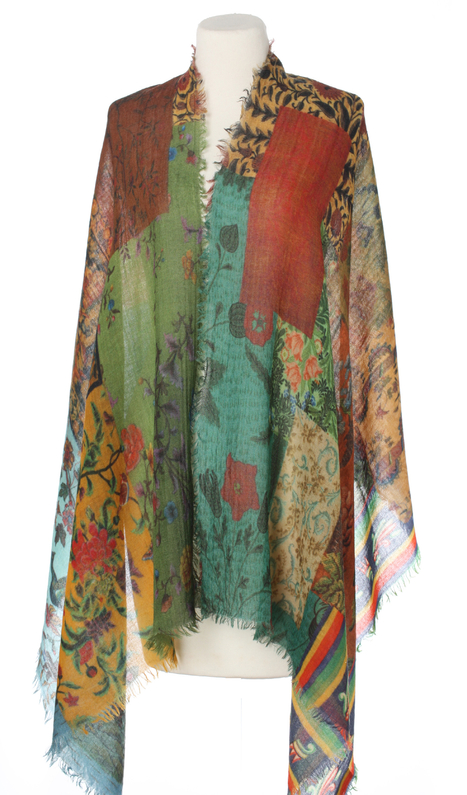Apaszki jedwabne stanowią synonim luksusu, elegancji i klasy. Są to dodatki, które nie tylko podkreślają nasz styl, ale również wnoszą odrobinę wyrafinowania do każdej stylizacji. W tym artykule opowiem o różnych rodzajach jedwabnych apaszek, ich historii, sposobach na ich stylizację oraz podpowiem, dlaczego warto mieć w swojej kolekcji włoskie apaszki jedwabne, apaszkę w panterkę, elegancki szal do płaszcza, bordową apaszkę, apaszkę jedwabną 90×90 oraz apaszkę różową.
Dlaczego Wybór Apaszki ma Znaczenie?
Apaszka to więcej niż tylko kawałek materiału – to wyraz osobowości i stylu. Dobrze dobrana apaszka może dodać charakteru każdej stylizacji, podkreślić kształt twarzy i nadać elegancki wygląd nawet najprostszym ubraniom. Włoskie apaszki jedwabne są szczególnie cenione na całym świecie za jakość jedwabiu i precyzję wykonania, która sprawia, że te dodatki stają się czymś wyjątkowym. Kupując jedwabną apaszkę, inwestujesz w akcesorium, które przetrwa próbę czasu i nie wyjdzie z mody przez wiele lat.
Włoskie Apaszki Jedwabne: Prestiż i Jakość
Włoska produkcja jedwabiu jest znana z wysokiej jakości, a włoskie apaszki jedwabne są prawdziwym dziełem sztuki. Jedwab używany do produkcji tych apaszek jest lekki, miękki, a jednocześnie trwały. Dzięki specjalnym technikom farbowania i tkania, włoskie apaszki zachowują żywe kolory i wzory przez wiele lat. Często zdobią je klasyczne wzory florystyczne, geometryczne lub abstrakcyjne, które dodają im ponadczasowego uroku. To doskonały wybór dla osób ceniących luksus i elegancję w każdym detalu.

Jak Stylizować Włoskie Apaszki Jedwabne?
Włoskie apaszki jedwabne pasują do wielu stylizacji. Możesz je nosić klasycznie, związane na szyi, albo zawiązać na głowie jako turban. Inną opcją jest przypięcie apaszki do torebki, co doda elegancji całemu lookowi. Możesz także spróbować owinąć ją wokół nadgarstka jako bransoletkę lub przywiązać wokół kapelusza, aby nadać mu charakteru. Dzięki uniwersalności jedwabnych apaszek możesz tworzyć nowe stylizacje, dostosowując je do różnych okazji i nastrojów.
Apaszka w Panterkę – Ekspresja i Styl
Jeśli chcesz dodać swojej stylizacji odrobinę drapieżności i ekspresji, apaszka w panterkę będzie idealnym wyborem. Wzór panterki to klasyka, która jest nie tylko modna, ale także pełna charakteru. Taka apaszka sprawdzi się świetnie w połączeniu z jednokolorowymi ubraniami, np. czarnymi, białymi lub beżowymi. Apaszka w panterkę może stać się centralnym punktem stylizacji, który przyciągnie uwagę i doda Ci pewności siebie.
Jak Nosimy Apaszkę w Panterkę?
Apaszka w panterkę świetnie sprawdza się zarówno na szyi, jak i jako dodatek do torebki lub ozdoba do włosów. Jeśli chcesz stworzyć modny look inspirowany latami 90., możesz przewiązać ją na głowie lub zawiązać jako choker. Taki wzór dodaje stylizacji odrobinę dzikości i wyrazistości, która przyciąga spojrzenia. Dodatkowo, apaszka w panterkę może być świetnym uzupełnieniem stylizacji boho, zwłaszcza w połączeniu z naturalnymi materiałami, takimi jak len czy bawełna.
Elegancki Szal do Płaszcza – Ciepło i Styl
Gdy temperatura spada, a my wciąż chcemy wyglądać stylowo, z pomocą przychodzi elegancki szal do płaszcza. Szal jedwabny to doskonały wybór na jesienne i zimowe dni, kiedy chcemy czuć się komfortowo i jednocześnie elegancko. Szale do płaszcza mogą być różnych rozmiarów, a jedwabne materiały sprawiają, że są lekkie, a zarazem ciepłe i wygodne.
Jak Dobierać Szal do Płaszcza?
Elegancki szal do płaszcza powinien być nie tylko piękny, ale również funkcjonalny. Jeśli masz płaszcz w neutralnych kolorach, jak beż czy szarość, możesz postawić na szal w intensywnym kolorze lub z wyrazistym wzorem. Jedwabne szale można wiązać na różne sposoby – luźno przewieszone przez ramię, zawiązane w klasyczny węzeł lub jako elegancką kokardę.
Bordowa Apaszka – Klasyka w Nowoczesnym Wydaniu
Kolor bordowy od zawsze kojarzył się z elegancją, a bordowa apaszka to doskonały wybór, jeśli szukasz klasycznego, a jednocześnie wyrazistego dodatku. Kolor bordowy pasuje do większości stylizacji, zwłaszcza do jesiennych i zimowych ubrań. Taka apaszka doda wyrafinowania nawet prostym stylizacjom, takim jak czarna sukienka czy biała koszula.
Stylizacje z Bordową Apaszką
Bordowa apaszka pięknie prezentuje się z eleganckimi płaszczami i marynarkami, dodając stylizacji charakteru. Można ją również nosić w bardziej swobodny sposób, wiążąc na szyi lub przypinając do torebki. Bordowy kolor świetnie komponuje się z granatowymi i beżowymi ubraniami, nadając im elegancji i klasy.

Apaszka Jedwabna 90×90 – Wygodna i Wszechstronna
Apaszka jedwabna 90×90 to jeden z najpopularniejszych rozmiarów jedwabnych apaszek. Rozmiar ten pozwala na wiele kreatywnych stylizacji, co czyni ją bardzo wszechstronnym dodatkiem. Możesz ją nosić na wiele sposobów – jako tradycyjną apaszkę na szyi, chustę na głowie lub nawet jako ozdobę do torebki.
Różnorodne Zastosowania Apaszki Jedwabnej 90×90
Apaszka jedwabna o wymiarach 90×90 świetnie sprawdza się jako turban, zwłaszcza latem, kiedy chcesz ochronić włosy przed słońcem i dodać stylizacji charakteru. Możesz też przewiązać ją wokół torebki, aby dodać jej elegancji. Kolejnym popularnym sposobem jest noszenie apaszki jako paska do spodni lub sukienki – to doskonały sposób na dodanie koloru i wzoru do codziennych stylizacji.
Apaszka Różowa – Delikatność i Świeżość
Apaszka różowa to wyjątkowo kobiecy dodatek, który nadaje stylizacji delikatności i romantycznego wyrazu. Kolor różowy jest symbolem subtelności, a apaszka w tym odcieniu sprawdzi się doskonale zarówno na co dzień, jak i na specjalne okazje. Możesz ją nosić z elegancką sukienką, koszulą lub jako dodatek do płaszcza.
Stylizacje z Apaszką Różową
Apaszka różowa pięknie komponuje się z białymi, beżowymi i pastelowymi ubraniami, nadając stylizacji lekkości. Można ją zawiązać na szyi, jako opaskę na głowę, czy też przypiąć do torebki. Różowa apaszka wprowadza nutę romantyzmu do stylizacji, dlatego będzie idealnym dodatkiem na randkę lub spotkanie z przyjaciółkami.
Podsumowanie
Apaszki jedwabne są niezwykle wszechstronnym dodatkiem, który warto mieć w swojej kolekcji. Włoskie apaszki jedwabne, apaszka w panterkę, elegancki szal do płaszcza, bordowa apaszka, apaszka jedwabna 90×90 oraz apaszka różowa to różnorodne propozycje, które doskonale sprawdzą się w różnych stylizacjach i sytuacjach. Dzięki apaszkom możemy wyrazić swoją osobowość, dodać stylizacji charakteru i zawsze wyglądać elegancko. Jedwabne apaszki to inwestycja, która będzie towarzyszyć Ci przez wiele lat, wnosząc do Twojej garderoby odrobinę luksusu i klasy.